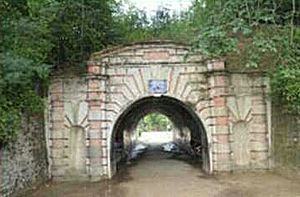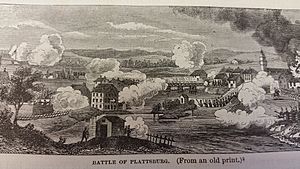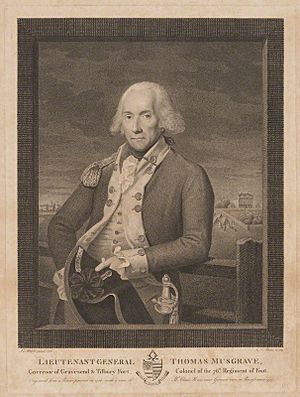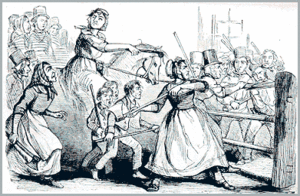76th Regiment of Foot facts for kids
Quick facts for kids 76th Regiment of Foot |
|
|---|---|

Cap badge of the 76th Regiment of Foot
|
|
| Active | 1787–1881 |
| Country | |
| Branch | |
| Type | Line Infantry |
| Size | 11 Companies |
| Garrison/HQ | Wellesley Barracks, Halifax |
| Nickname(s) | The Immortals The Pigs The Old Seven and Sixpennies |
| Motto(s) | none |
| Colors | Red Facings |
| March | Quick: "Scotland the Brave" Slow: "Logie o'Buchan" |
| Mascot(s) | Indian Elephant |
| Engagements | Third Anglo-Mysore War Second Anglo-Maratha War Napoleonic Wars War of 1812 |
| Commanders | |
| Last Commanding Officer | Lieutenant Colonel JMD Allardice (1880–1881) |
| Last Colonel of the Regiment | General Fredrick Darley George CB (1875–1881) |
The 76th Regiment of Foot was a special group of soldiers in the British Army. It was created in 1787. This regiment was known for its brave actions in many battles around the world.
Later, in 1881, the 76th Regiment joined with another group, the 33rd (Duke of Wellington's) Regiment. This happened because of new army rules called the Childers Reforms. Together, they formed the larger Duke of Wellington's Regiment.
Contents
History of the 76th Regiment
How the Regiment Started
The 76th Regiment of Foot was formed in October 1787. It was started by a man named Sir Thomas Musgrave, 7th Baronet. The main reason for creating this new group of soldiers was to send them to India.
Most of the new soldiers came from places like Nottingham and Leicestershire in England. Some also came from Sir Thomas Musgrave's family lands. The government helped pay for the regiment, especially since they were going to serve in India.
Adventures in India

In 1788, the regiment sailed to India. They fought in the Third Anglo-Mysore War. They were part of important battles like the Siege of Bangalore in 1791 and the Siege of Seringapatam in 1792.
The 76th Regiment also fought in the Second Anglo-Maratha War. A famous battle was the Siege of Aligarh in September 1803. The soldiers had to attack Aligarh Fort. This fort was very strong, with deep ditches and sharp blades. The French officers helping the Marathas even used tigers and lions to scare the attackers! Despite this, the 76th Regiment captured the fort.
They continued to fight in other big battles, including the Battle of Delhi and the Battle of Laswari in 1803. Because of their bravery, King George III gave them a special honour. The word "Hindoostan" was added to their flags. They also got an elephant badge, which became a symbol of their courage in India.
In 1806, the regiment returned to England. They were then called the 76th (Hindoostan) Regiment of Foot.
Fighting in the Napoleonic Wars

In 1807, the regiment moved to Jersey in the Channel Islands. Then, in 1808, they went to Spain to fight in the Peninsular War. They were part of the Battle of Corunna in 1809.
After a difficult campaign, they returned home. They also took part in the Walcheren Campaign in 1809. In 1812, their name changed back to the 76th Regiment of Foot. They went back to Spain in 1813. There, they fought in the Battle of Nivelle and the Battle of the Nive.
Later, the regiment sailed to North America. They fought in the War of 1812. A key battle they were involved in was the Battle of Plattsburgh in September 1814.
The Victorian Era and Changes
The 76th Regiment returned from North America in 1827. For many years, they moved to different places around the world. They were stationed in Ireland, the West Indies, Bermuda, and Canada. In 1842, they came back to England.
That same year, they helped stop the Rebecca Riots in South Wales. These were protests by farmers against unfair taxes. The regiment then served in places like Corfu and Malta. Later, they went back to North America, serving in New Brunswick.
In 1863, they returned to India. They were stationed in Madras and also served in Burma. Finally, in 1876, they sailed back to England.
In the 1870s, the British Army made big changes. These were called the Cardwell Reforms. Different regiments were linked together. The 76th Regiment was linked with the 33rd (Duke of Wellington's) Regiment. They shared a base in Halifax.
On July 1, 1881, more changes happened with the Childers Reforms. The 76th Regiment officially joined with the 33rd Regiment. They became one new group called the Duke of Wellington's Regiment. This marked the end of the 76th Regiment of Foot as a separate unit.
Battle Honours
The 76th Regiment earned special honours for their bravery in battles. These honours were displayed on their flags:
- Hindoostan
- Peninsular War: Nive, Peninsula
Colonels of the Regiment
A Colonel of the Regiment was a very important leader. Here are some of the people who held this role:
- 1787–1812: Gen. Sir Thomas Musgrave, 7th Baronet (who started the regiment)
- 1875–1881: Gen. Frederick Darley George, CB (the last Colonel before the regiment joined with another)



